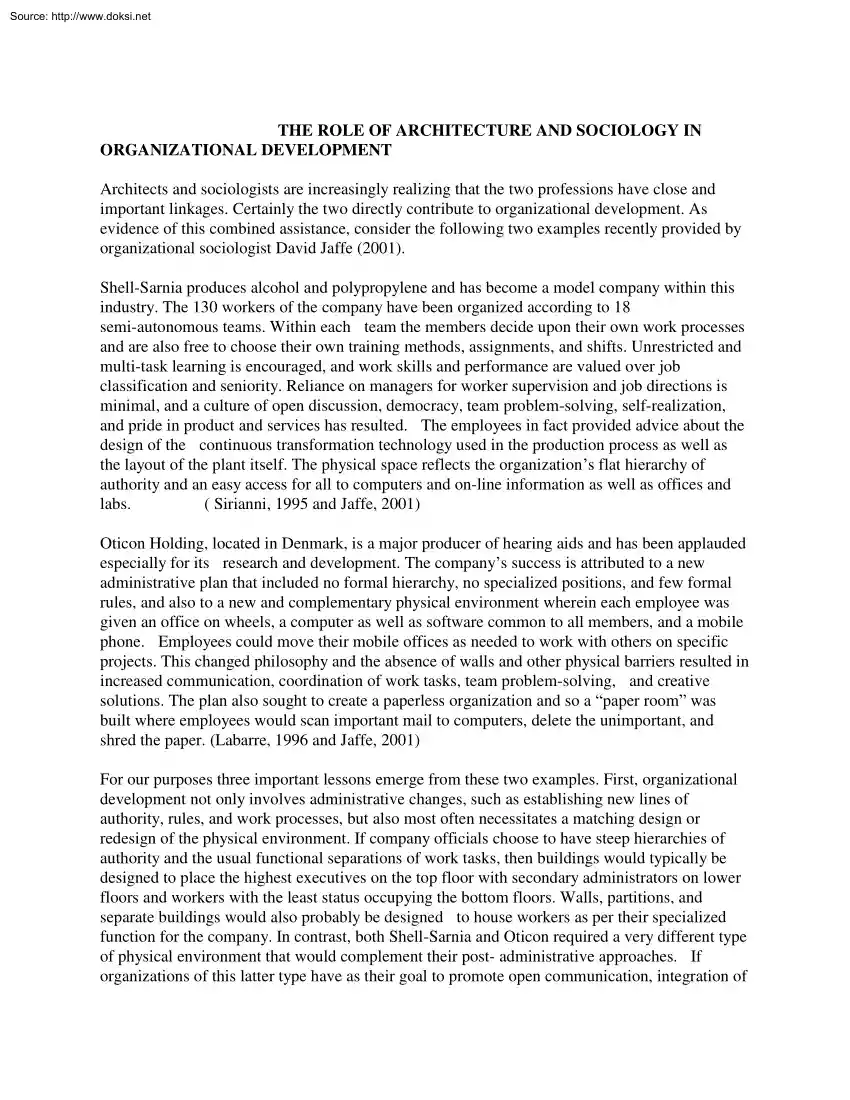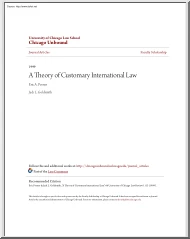Please log in to read this in our online viewer!

Please log in to read this in our online viewer!
No comments yet. You can be the first!
What did others read after this?
Content extract
Source: http://www.doksinet THE ROLE OF ARCHITECTURE AND SOCIOLOGY IN ORGANIZATIONAL DEVELOPMENT Architects and sociologists are increasingly realizing that the two professions have close and important linkages. Certainly the two directly contribute to organizational development As evidence of this combined assistance, consider the following two examples recently provided by organizational sociologist David Jaffe (2001). Shell-Sarnia produces alcohol and polypropylene and has become a model company within this industry. The 130 workers of the company have been organized according to 18 semi-autonomous teams. Within each team the members decide upon their own work processes and are also free to choose their own training methods, assignments, and shifts. Unrestricted and multi-task learning is encouraged, and work skills and performance are valued over job classification and seniority. Reliance on managers for worker supervision and job directions is minimal, and a culture of open
discussion, democracy, team problem-solving, self-realization, and pride in product and services has resulted. The employees in fact provided advice about the design of the continuous transformation technology used in the production process as well as the layout of the plant itself. The physical space reflects the organization’s flat hierarchy of authority and an easy access for all to computers and on-line information as well as offices and labs. ( Sirianni, 1995 and Jaffe, 2001) Oticon Holding, located in Denmark, is a major producer of hearing aids and has been applauded especially for its research and development. The company’s success is attributed to a new administrative plan that included no formal hierarchy, no specialized positions, and few formal rules, and also to a new and complementary physical environment wherein each employee was given an office on wheels, a computer as well as software common to all members, and a mobile phone. Employees could move their mobile
offices as needed to work with others on specific projects. This changed philosophy and the absence of walls and other physical barriers resulted in increased communication, coordination of work tasks, team problem-solving, and creative solutions. The plan also sought to create a paperless organization and so a “paper room” was built where employees would scan important mail to computers, delete the unimportant, and shred the paper. (Labarre, 1996 and Jaffe, 2001) For our purposes three important lessons emerge from these two examples. First, organizational development not only involves administrative changes, such as establishing new lines of authority, rules, and work processes, but also most often necessitates a matching design or redesign of the physical environment. If company officials choose to have steep hierarchies of authority and the usual functional separations of work tasks, then buildings would typically be designed to place the highest executives on the top floor
with secondary administrators on lower floors and workers with the least status occupying the bottom floors. Walls, partitions, and separate buildings would also probably be designed to house workers as per their specialized function for the company. In contrast, both Shell-Sarnia and Oticon required a very different type of physical environment that would complement their post- administrative approaches. If organizations of this latter type have as their goal to promote open communication, integration of Source: http://www.doksinet work units, and team problem-solving, and to encourage self-directed, creative, and extremely dedicated workers, then perhaps removal of walls, and creation of magnet centers, “think rooms,” and on-location ancillary services, such as day care, banking, car service, and restaurants, should be considered as part of the architectural design. Second, successful attempts at organizational development are seldom approached blindly. Initiating a new
administrative approach and/or designing a new building requires that we do the necessary research by gaining the input from all the major stakeholders, including the workers, managers, owners, directors, and existing as well as prospective clients. Careful evaluation of the successes and failures of similar organizations that have implemented related administrative approaches and physical environments would also be beneficial. Evaluative research after the new administrative plan and new construction are in place should be equally rigorous and thorough. Sound research is as much a vital part of all phases of the new administrative plan as it is for all construction phases-- predesign and programming, design, construction, and post-construction. Ultimately, the research goal is to assess the impact of the new administrative change and/or the new physical environment on organizational development. Third, successful organizational development efforts derive from well established and
over-lapping sociological, psychological, and business theories. For example, the organizational development efforts of Shell-Sarina and Oticon reflect emerging post-bureaucratic theory, systems theory, networking and team building theory, social psychological theories that focus on worker participation, empowerment and self realization, and theories that emphasize the importance of integrated organizational cultures for organization success. Architectural sociologists draw upon their organizational theories and their research to describe how the physical environment reflects managerial philosophies and also to analyze how the physical environment subsequently impacts the participants, processes, and outcomes of the organization (Becker and Steel, 1995). Thus, as just a few examples these sociologists could be of assistance to the architect on matters of building and landscape design, choice of furnishings, layout of work stations, locations of conference and break rooms, decision
about who receives valued space, public perceptions of a company based on building layout and aesthetics, and if physical environment assisted the organization in its development. References: Becker, Frank and Fritz Steele. 1995 Workplace by Design: Mapping the High Performance Workspace. San Francisco: Jossey Bass Jaffe, David. 2001 Organizational Theory: Tension and Change New York: McGraw Hill Labarre, Polly.1996 “The Organization is Disorganization” Fast Company 3:77 Online document at: www.fastcompanycom/online03/oticonhtml Sirianni, Carmen. 1995 “Union and Management Collaborate to Democratize Work at the Source: http://www.doksinet Shell-Sarnia Plant.” Online document at: wwwcpnorg/sections/topics/workhtml
discussion, democracy, team problem-solving, self-realization, and pride in product and services has resulted. The employees in fact provided advice about the design of the continuous transformation technology used in the production process as well as the layout of the plant itself. The physical space reflects the organization’s flat hierarchy of authority and an easy access for all to computers and on-line information as well as offices and labs. ( Sirianni, 1995 and Jaffe, 2001) Oticon Holding, located in Denmark, is a major producer of hearing aids and has been applauded especially for its research and development. The company’s success is attributed to a new administrative plan that included no formal hierarchy, no specialized positions, and few formal rules, and also to a new and complementary physical environment wherein each employee was given an office on wheels, a computer as well as software common to all members, and a mobile phone. Employees could move their mobile
offices as needed to work with others on specific projects. This changed philosophy and the absence of walls and other physical barriers resulted in increased communication, coordination of work tasks, team problem-solving, and creative solutions. The plan also sought to create a paperless organization and so a “paper room” was built where employees would scan important mail to computers, delete the unimportant, and shred the paper. (Labarre, 1996 and Jaffe, 2001) For our purposes three important lessons emerge from these two examples. First, organizational development not only involves administrative changes, such as establishing new lines of authority, rules, and work processes, but also most often necessitates a matching design or redesign of the physical environment. If company officials choose to have steep hierarchies of authority and the usual functional separations of work tasks, then buildings would typically be designed to place the highest executives on the top floor
with secondary administrators on lower floors and workers with the least status occupying the bottom floors. Walls, partitions, and separate buildings would also probably be designed to house workers as per their specialized function for the company. In contrast, both Shell-Sarnia and Oticon required a very different type of physical environment that would complement their post- administrative approaches. If organizations of this latter type have as their goal to promote open communication, integration of Source: http://www.doksinet work units, and team problem-solving, and to encourage self-directed, creative, and extremely dedicated workers, then perhaps removal of walls, and creation of magnet centers, “think rooms,” and on-location ancillary services, such as day care, banking, car service, and restaurants, should be considered as part of the architectural design. Second, successful attempts at organizational development are seldom approached blindly. Initiating a new
administrative approach and/or designing a new building requires that we do the necessary research by gaining the input from all the major stakeholders, including the workers, managers, owners, directors, and existing as well as prospective clients. Careful evaluation of the successes and failures of similar organizations that have implemented related administrative approaches and physical environments would also be beneficial. Evaluative research after the new administrative plan and new construction are in place should be equally rigorous and thorough. Sound research is as much a vital part of all phases of the new administrative plan as it is for all construction phases-- predesign and programming, design, construction, and post-construction. Ultimately, the research goal is to assess the impact of the new administrative change and/or the new physical environment on organizational development. Third, successful organizational development efforts derive from well established and
over-lapping sociological, psychological, and business theories. For example, the organizational development efforts of Shell-Sarina and Oticon reflect emerging post-bureaucratic theory, systems theory, networking and team building theory, social psychological theories that focus on worker participation, empowerment and self realization, and theories that emphasize the importance of integrated organizational cultures for organization success. Architectural sociologists draw upon their organizational theories and their research to describe how the physical environment reflects managerial philosophies and also to analyze how the physical environment subsequently impacts the participants, processes, and outcomes of the organization (Becker and Steel, 1995). Thus, as just a few examples these sociologists could be of assistance to the architect on matters of building and landscape design, choice of furnishings, layout of work stations, locations of conference and break rooms, decision
about who receives valued space, public perceptions of a company based on building layout and aesthetics, and if physical environment assisted the organization in its development. References: Becker, Frank and Fritz Steele. 1995 Workplace by Design: Mapping the High Performance Workspace. San Francisco: Jossey Bass Jaffe, David. 2001 Organizational Theory: Tension and Change New York: McGraw Hill Labarre, Polly.1996 “The Organization is Disorganization” Fast Company 3:77 Online document at: www.fastcompanycom/online03/oticonhtml Sirianni, Carmen. 1995 “Union and Management Collaborate to Democratize Work at the Source: http://www.doksinet Shell-Sarnia Plant.” Online document at: wwwcpnorg/sections/topics/workhtml




